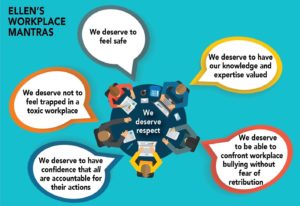
Bullying – you can’t escape the word. It’s bandied around to describe behaviours in the school yard, in the workplace, in politics and beyond. It has been described as an epidemic, with costs that are estimated in the billions to the Australian economy each year. It’s talked about in the press, on social media and in whispered conversations.
There is now a more broadly accepted acknowledgement from legislators and society in general that bullying behaviours are no longer just the price of doing business. That it’s not just people “having a joke”. There is an understanding that it’s no longer acceptable to just let the issue slide (because the person is important to the organisation, even if the behaviours aren’t ok).
There’s clarity around what we mean when we talk about bullying, and importantly what we don’t. We can point to examples of bullying behaviours and talk about real life case studies. There’s an understanding that bullying can be a psycho-social hazard and that there can be implications for a worker’s health and safety just like any other hazard. There’s some support available now from the Fair Work Commission in the form of stop bullying orders. There’s more training, better, more effective training.
There’s been progress. And yet, in so many ways the progress is painfully slow and ineffectual.
On a weekly basis, I am contacted by people, some known to me, many unknown, asking how to handle the bully in their lives. It’s not that these people work in organisations that don’t have HR or policies on how to handle bullying complaints. By and large they do. The theory is all pretty clear – in the event you find yourself in this situation, these are the steps you should take. This is the form you should complete. This is who you should talk to.
The stories all have a consistency about them. “Yes, I have been to HR, but they can’t do anything unless I put in a formal complaint, and I don’t want to make the bullying worse”. “Yes, I have put in a formal complaint, but it was “investigated” by a manager who is friends with the bully”. “Yes, I’ve put in a complaint, but I was told by management to stop being so precious and get on with the job”. “Yes, I have put in a complaint, but I was told I just need to be more resilient, and that the bully is having a hard time at the moment”. “Yes, I have been to my manager – but he doesn’t “do” conflict”. “Yes, I have told the bully to stop, and it has gotten worse”. “Yes, I’ve told my manager, but he thinks the jokes are funny, so I have just stopped being in the same room as the bully”.
As Tasha Broomhall, Director, Blooming Minds says:
“Organisations have regulated responsibilities around work health and safety, which includes for both mental and physical health. Bullying behaviour is not only a risk to individuals who may experience it but is also an important organisational risk to manage. It is important that employees know the processes and supports available to raise concerns about bullying. However, a procedure is not enough. Organisations need to ensure that the system is working. That when claims are made, they are responded to in a fair, equitable, and (while conscious of individual privacy) in a systemically transparent manner. This is a WHS issue and cannot be ignored.”
Just having the procedure isn’t enough. Doing the training is no longer enough. Organisations now need to think through how they handle issues when they are raised. How do they manage the complaint around the high performer? Do HR and managers have skills in both investigating and addressing hard issues in a fair manner that keeps all parties safe? Does the organisation offer bystander training and support? How are the issues being looked at more systemically to address trends and nip areas of concern in the bud?
In short, organisations need to have hard conversations at the most senior level around how serious they are around addressing bullying behaviours. Those that don’t will find themselves increasingly exposed to health and safety and other legal claims. And in a hot employment market, the organisations that harbour and protect bullies to save themselves some short term pain will get a reputation that precedes them. It’s time for organisations to grow up.

